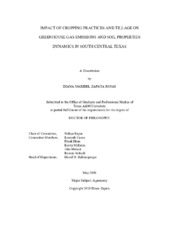| dc.contributor.advisor | Rajan, Nithya | |
| dc.creator | Zapata Rojas, Diana Maribel | |
| dc.date.accessioned | 2019-10-16T20:34:08Z | |
| dc.date.available | 2021-05-01T12:34:45Z | |
| dc.date.created | 2019-05 | |
| dc.date.issued | 2019-04-10 | |
| dc.date.submitted | May 2019 | |
| dc.identifier.uri | https://hdl.handle.net/1969.1/185022 | |
| dc.description.abstract | Over the last two centuries, changes in land use and management from agricultural activities have impacted environmental quality and soil productivity. Although soils store substantial amounts of carbon (C) (second largest sink after oceans), intensive tillage practices have accelerated the decomposition of soil organic matter and the release of carbon dioxide (COv2) into the atmosphere. The greenhouse gas (GHG) mitigation potential of soils, is often overlooked, and limited data is available for accurately quantifying emissions. The objective of this dissertation was to investigate the impact of cropping practices and tillage on GHG emissions in southcentral Texas. We performed three research studies that quantified GHG emissions, soil C balance, and soil physical and chemical properties from long-term conventional and transitioning organic systems. In the first study, the dynamics of soil COv2 emissions (Rvs) and soil environmental conditions as influenced by long-term tillage were investigated at an experimental site established in 1982. Rvs was measured in the monoculture soybean (Glycine max (L.) Merr.) and winter wheat (Triticum aestivum L.)/soybean rotation cropping systems under conventional and no-tillage practices in 2016. Rotational cropping showed similar soil temperatures between tillage treatments, but higher soil moisture with no-till reduced Rvs. Monoculture soybean showed the opposite trend to rotational cropping, with higher soil temperatures under conventional till that possibly suppressed microbial activity and Rvs. In the second study, we quantified GHG emissions and soil properties from an unmanaged cropland that transitioned into organic corn (Zea mays L.) production on a Vertisol in 2016. Four production systems were evaluated including fall/winter cover crops and reduced tillage practices during 2017 and 2018. During 2017, Rvs was higher than in 2018 in all production systems, but the average treatment effect was similar between years. No-tillage resulted in higher GHG emissions as soil cracking occurred.
The third study investigated cover crop decomposition (legume vs cereal/legume mixture) through an incubation experiment and a litter bag experiment in 2018. We identified possible stages in microbial growth and activity that regulated nutrient mineralization-immobilization. This research provided important insights into GHG emissions and C and N balance from agricultural systems in Texas. | en |
| dc.format.mimetype | application/pdf | |
| dc.language.iso | en | |
| dc.subject | Greenhouse gases | en |
| dc.subject | cover cropping | en |
| dc.subject | soil organic carbon | en |
| dc.title | Impact of Cropping Practices and Tillage on Greenhouse Gas Emissions and Soil Properties Dynamics in South Central Texas | en |
| dc.type | Thesis | en |
| thesis.degree.department | Soil and Crop Sciences | en |
| thesis.degree.discipline | Agronomy | en |
| thesis.degree.grantor | Texas A & M University | en |
| thesis.degree.name | Doctor of Philosophy | en |
| thesis.degree.level | Doctoral | en |
| dc.contributor.committeeMember | Casey, Kenneth | |
| dc.contributor.committeeMember | Hons, Frank | |
| dc.contributor.committeeMember | McInnes, Kevin | |
| dc.contributor.committeeMember | Mower, Jake | |
| dc.contributor.committeeMember | Schnell, Ronnie | |
| dc.type.material | text | en |
| dc.date.updated | 2019-10-16T20:34:08Z | |
| local.embargo.terms | 2021-05-01 | |
| local.etdauthor.orcid | 0000-0001-5643-3655 | |


